Livestock get the stamp spotlight with new U.S. stamps featuring heritage breeds.
Heritage livestock breeds were the province of a small group of dedicated farmers a few years ago. Now, everyone can appreciate them on postage stamps. The U.S. Postal Service is selling stamps that feature 10species.
“Rare farm animals represent an irreplaceable piece of Earth’s biodiversity and offer incredible variety that may be needed for future farms – robust health, mothering instincts, foraging, and the ability to thrive in a changing climate,” The Livestock Conservancy website says, to explain why heritage breed livestock need conservation. “These farm animals are a vital part of ensuring food security for our planet – now and for the future.”
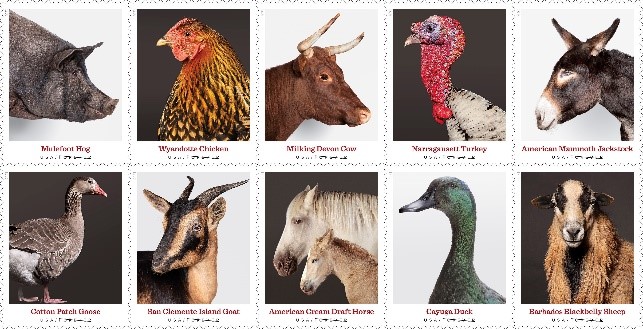
Heritage Breed Stamps, photos by Aliza Eliazarov
‘Who Designs Stamps?’
That was the question Jody Jess of Buckhill Homestead Farm in Massachusetts asked back in 2014. She wanted to shine some light on heritage breeds and the breeders dedicated to keeping them.
“It’s important that these breeds get recognized,” she says. “Most people don’t know about the heritage livestock that are the foundation of our farms.”
Jess is one of those dedicated breeders, keeping Kerry cattle; Irish Dexter cows; Gloucestershire Old Spots pigs; Muscovy ducks; and Buff Orpington, Wyandotte, and one Buckeye chicken. She contributes data from her Kerry cattle herd to a project at the University of California, Davis.
As she was mailing data to them one day in 2014, she asked the post office clerk what it would take to get heritage livestock breeds featured. He told her about the U.S. Postal Service Citizens Stamp Advisory Committee (CSAC)and got her the paperwork required to submit an idea.
The application required her to write an essay making the case for heritage livestock breeds featured on stamps. Jody’s friend Emily Aho helped her with that.
About a year later, CSAC sent her a letter telling her that the idea had been accepted. At that point, it was out of her hands. They’d take it from there.
Breeds From 10 Species
CSAC turned to The Livestock Conservancy for suggestions about which breeds to feature on the stamps. Technical advisor Phil Sponenberg recommended North American breeds from the Conservancy’s Conservation Priority List. They settled on Wyandotte chicken, Narragansett turkey, Cotton Patch goose, Cayuga duck, American Mammoth Jackstock donkey, San Clemente Island goat, Mulefoot hog, American Cream draft horse, Barbados Blackbelly sheep, and Milking Devon cow.
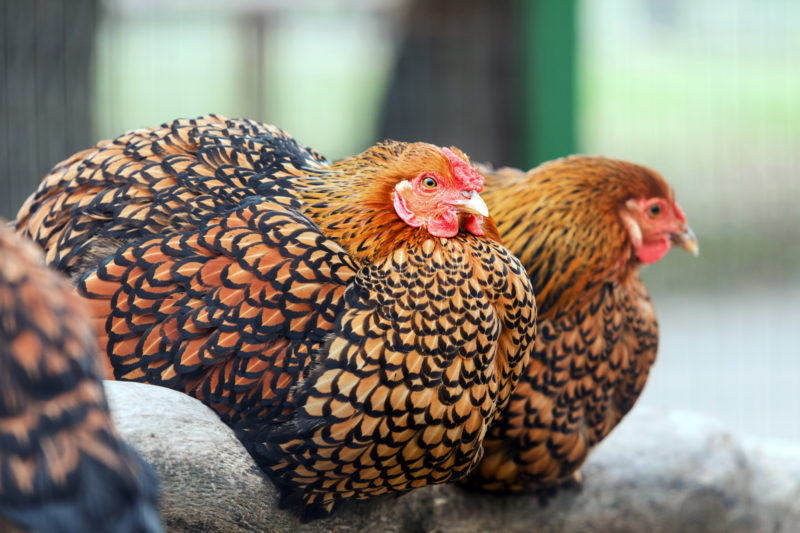
Golden Laced Wyandotte, AdobeStock/Alexandra Woods
Golden Laced Wyandotte: The stamp features the Golden Laced variety, one of nine recognized by the American Poultry Association (APA). This variety was developed in Wisconsin, from Silver Laced Wyandottes in New York State in the late 19th century. This variety is cold-hardy! Its smooth, broad feathers and smooth-fitting plumage create its distinctive, curvaceous silhouette. Even the rose comb curves around the head, fitting neatly and closely, rather than having its spike stand out.

Narragansett turkey, photo by Aliza Eliazarov
Narragansett turkey: Turkeys are uniquely American, first domesticated by Native Americans in the Southwest and Mexico. The Narragansett takes its name from the Rhode Island area, where it developed as a domestic offshoot of the Standard Bronze in the 19th century. Its silver and buff feather pattern distinguishes it, but it’s also popular for its easy-going disposition, cold-hardiness, and good meat and eggs. Frank Reese raises them on his Good Shepherd Poultry Ranch in Kansas, where he’s founded the Good Shepherd Conservancy to conserve Standardbred poultry.
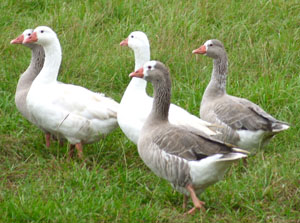
Cotton Patch goose, photo courtesy of The Livestock Conservancy
Cotton Patch goose: These geese are a landrace, a breed that developed through natural selection. They take their name from the work they’ve traditionally done: weeding cotton and tobacco fields. Ganders and hens have different plumage, called “sex-linked” or “auto-sexing,” making them easier to tell apart than other geese. Ganders are white, and hens are gray or saddle-backed. Their bills are pink or orange-pink. They’re light- to medium in weight and can usually fly well.
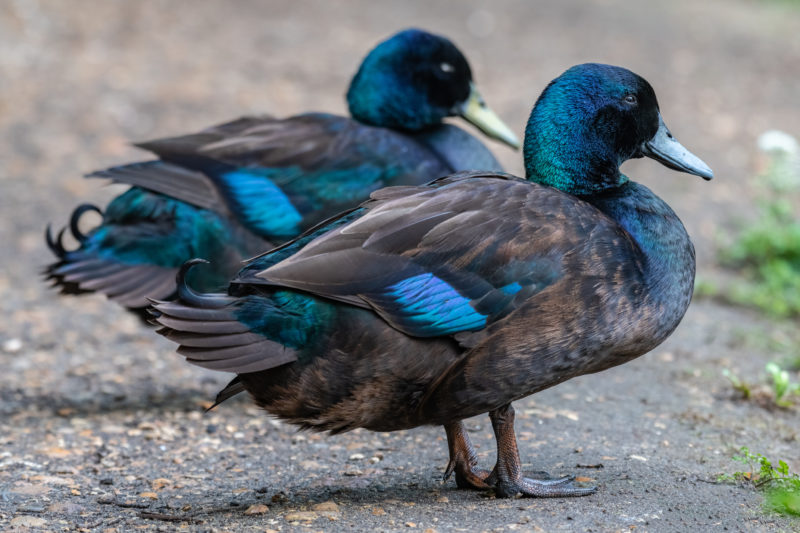
Cayuga duck, Adobe Stock/Tomasz
Cayuga duck: This solid-black duck, its glossy plumage glistening green, likely traces its origins to wild ducks in New York, with some domestic ducks crossed in. They were described in the early 19th century and recognized in the first edition of the APA Standard of Perfection in 1874. Cayugas are general-purpose ducks, making good roasters and laying up to 150 eggs annually. Their eggs are black, with color fading to white later in the season.

American Mammoth Jackstock donkey, photo courtesy of The Livestock Conservancy
American Mammoth Jackstock donkey: George Washington was among the enthusiasts who helped breed this distinctively American donkey. “Mammoth” refers to its size, historically at least 14.2 hands at the withers for jacks, 14 hands for jennies. Their ears may be 33 inches — nearly a yard — long. Their value is in producing mules for draft use; livestock protection; and recreational uses, such as riding and driving. Their historic color is black, but sorrel has become popular. Black strains are especially at risk, but the entire breed is on the The Livestock Conservancy’s Critical List.
You can read more about this amazing breed in this article by Jeannette Beranger, The Livestock Conservancy’s senior conservator: “The Mammoth Jackstock Donkey”
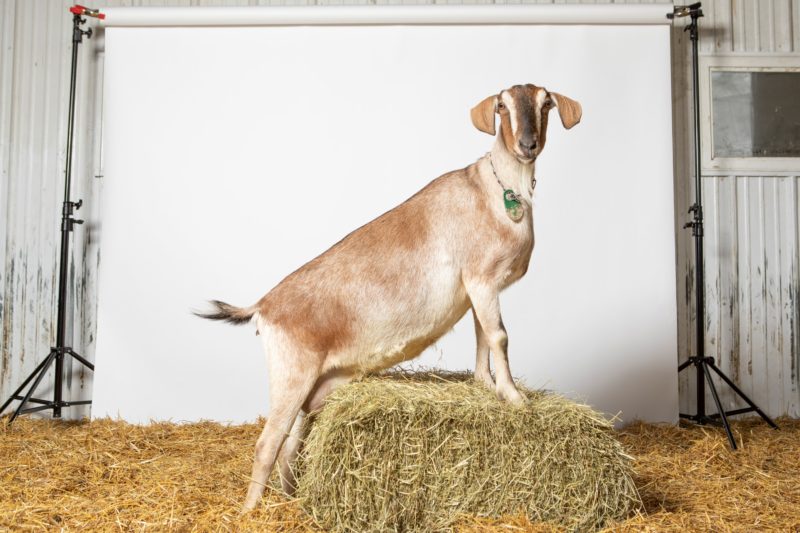
San Clemente Island goats, photo by Aliza Eliazarov
San Clemente Island goat: This breed developed on San Clemente Island, off the coast of Southern California, after 1875. Declared a threat to native wildlife in 1972, the remaining goats were protected and adopted off the island in 1980. Contemporary genetic studies show the breed is unrelated to Spanish goats or other goats, so their ancestral identity is undetermined. They’re small, but not as small as dwarf goats. They’re deer-like, red or tan with distinctive black markings, and have large horns. Those years on the island make them good foragers, hardy, and good mothers.
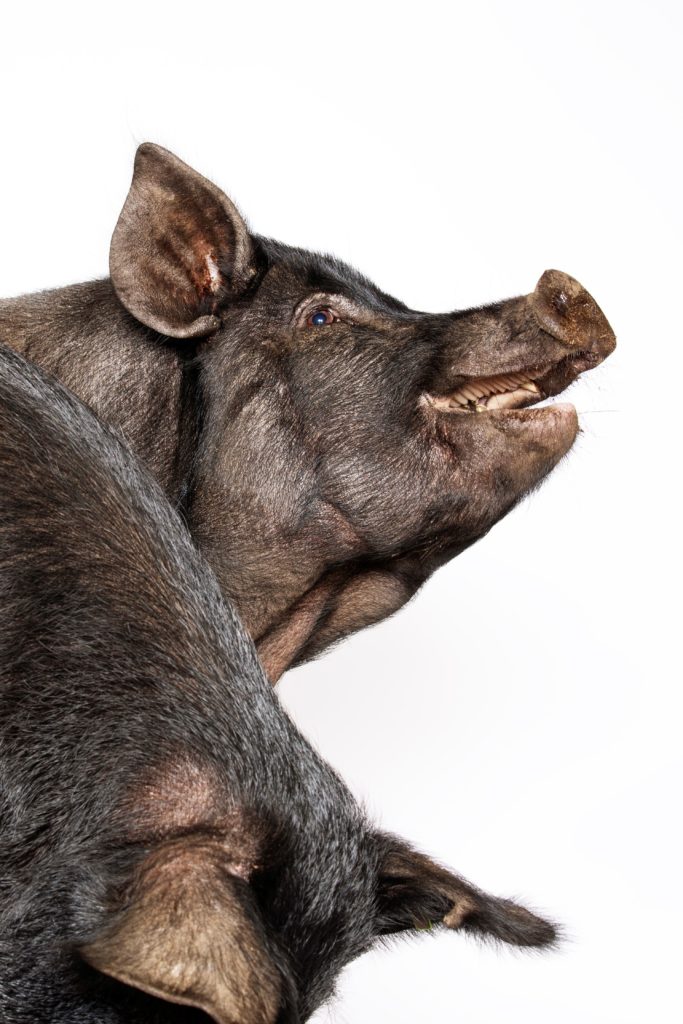
Mulefoot hogs, photo by Aliza Eliazarov
Mulefoot hog: Instead of the usual cloven hoof, Mulefoot hogs have a solid hoof like a mule. They probably owe their ancestry to Spanish hogs brought to the American continent in the 16th century. They forage for themselves, and it was common for farmers along the Mississippi River in the late 19th and early 20th centuries to set them out on islands in the spring to manage for themselves, and then they’d collect them in the fall. Mulefoot hogs gain weight easily, up to 600 pounds, and are known for their hams. They’re usually solid black, with ears that prick forward.
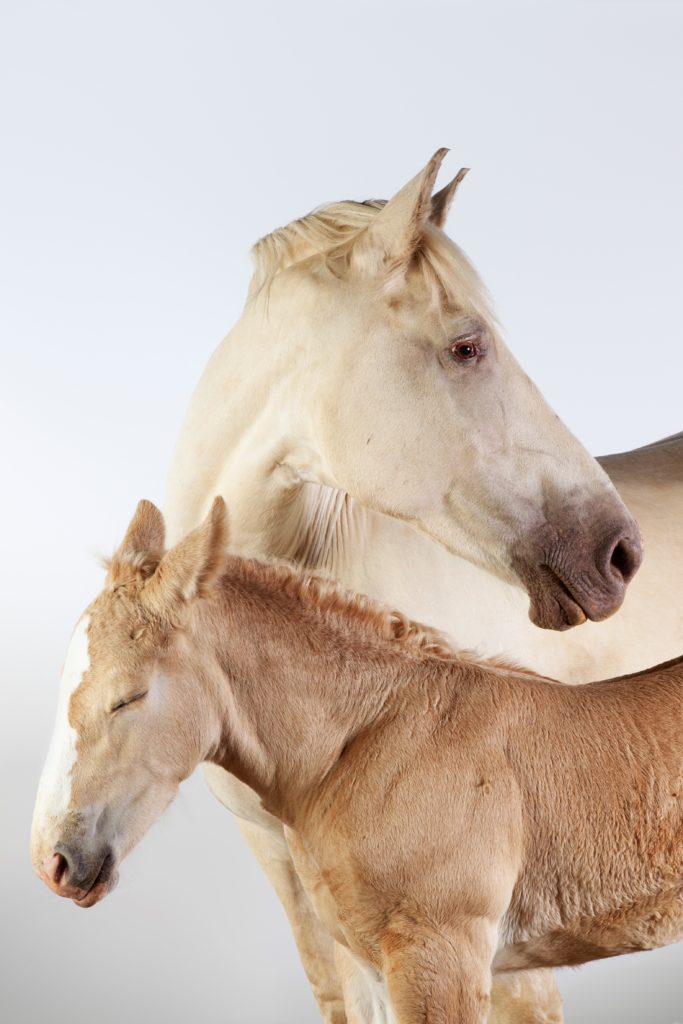
American Cream draft horse, photo by Aliza Eliazarov
American Cream draft horse: This distinctly American draft horse traces back to a mare, Old Granny, born around the turn of the 20th century, whose foals were always cream. Today, American Creams retain that unique coloring, with pink skin, amber eyes, and white manes and tails. Photographing this mare and foal pair for the stamps was a special treat for photographer Aliza Eliazarov. American Creams are medium-to-large horses, willing to be trained to work in harness. American Creams work well for farmers pursuing sustainable practices.
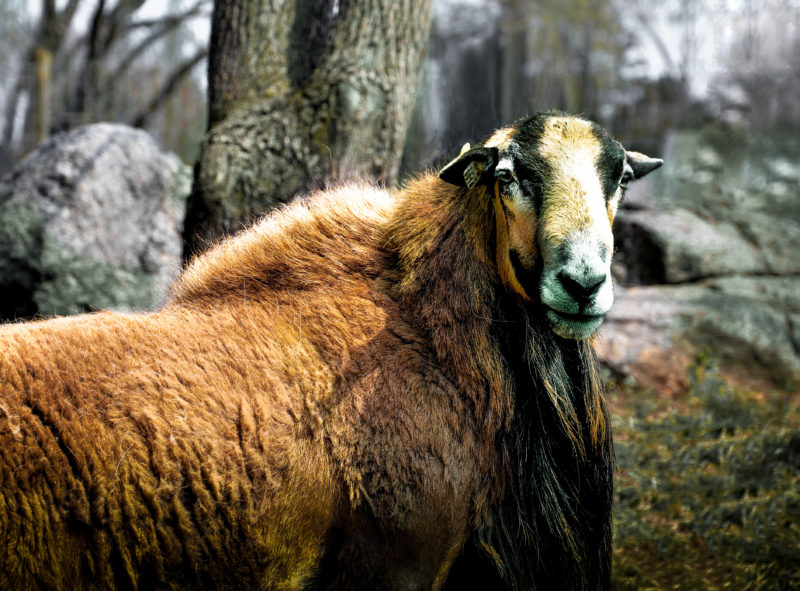
Barbados Blackbelly sheep, ram in Virginia, Adobe Stock/Jennifer
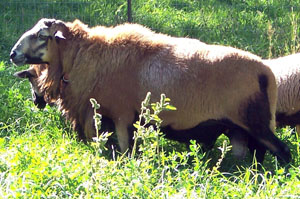
Barbados Blackbelly sheep, photo courtesy of The Livestock Conservancy
Blackbelly sheep: This hair sheep, whose origins are in Africa, thrives in the hot, humid weather of the American South and the Caribbean. Most sheep, with their heavy wool coats, need a cooler climate. Two breeds are recognized, Barbados and American Blackbelly. They’re reddish brown or tan, with black on the belly, legs, and facial bars. These sheep are sturdy, can forage for their own living, resist disease, and tolerate worm infestation. They can lamb year-round. The Livestock Conservancy finds that this breed is recovering, and so they moved this breed from their Critical List to their Watch List.
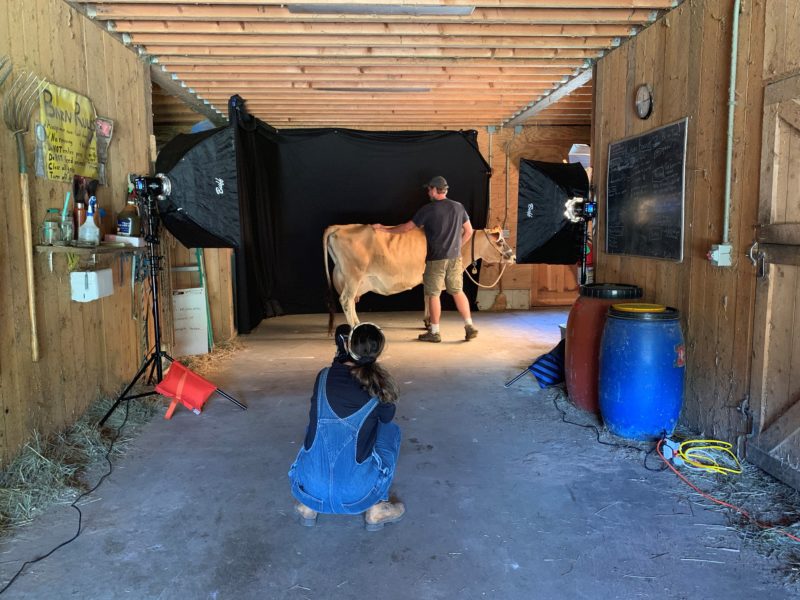
Milking Devon cow, photo by Aliza Eliazarov
Milking Devon cow: This breed came from its English home, from which it takes its name, with 17th century colonists. It suited American farmers for milk and meat and as a draft ox. Hardy and good-natured, Devons thrive even under harsh conditions, foraging for feed. Pressures to specialize Devons into a beef breed threatened their all-around usefulness, but their champions preserved the milking stock. They’re red with black-tipped white horns.
Designing the stamps
CSAC approached Journey Group, a design firm in Charlottesville, Virginia, that’s designed other stamps. Art director Greg Breeding asked staff designer Zack Bryant to do some research and come up with initial sketches. A livestock keeper himself, the first thing that came to his mind was Modern Farmer magazine, which featured individual animal photos on its cover before it went fully digital. Aliza Eliazarov took those photos.
“I knew we had to find this person,” he says. “She came to mind immediately. She’s a wonderful woman, photographer, and artist. Had she not wanted to do it, I don’t know what we would have done.”
Eliazarov had spent 10 years taking photos of livestock, honing her techniques. Her book, On the Farm, includes more than 150 photos.

Postcards, photos by Aliza Eliazarov
Taking their pictures
Once the decision was made as to which breeds to include, Eliazarov had to locate the animals and take their pictures. The techniques she’s perfected over the years include setting up a temporary studio in a barn, stall, or garage, where she can control the light and isolate the animal against the backdrop.
She allows the animals time to get comfortable and gives them treats so that she can capture each one’s inner Cindy Crawford. They surprise their keepers when they rise to the occasion.
“Every farmer is speechless,” she says. “They will say, ‘She’s usually really shy.’ Some seem to say, ‘Make me famous.’ They work it.”
Eliazarov created a set of postcards from the photos, for those who want more. They’re available on her website.
If you’re keeping heritage poultry breeds, you can participate in The Livestock Conservancy’s Poultry Census.
Contacts:
Zack Bryant
Journey Group
418 Fourth Street NE
Charlottesville, VA 22902
ZackB@JourneyGroup.com
Aliza Eliazarov
53 Tilton Ave.
Kittery, ME
03904
Aliza@AlizaEliazarov.com
Jody Jess
Buckhill Homestead Farm
51 Fred Smith Rd.
Westminster, MA 01473
JessRacin@Comcast.net
Christine Heinrichs writes from her home on California’s central coast. She keeps a backyard flock of a dozen hens, eight large fowl of various breeds and four Bantams.
Her book, How to Raise Chickens, was first published in 2007, just as the local food movement was starting to focus attention on the industrial food system. Backyard chickens became the mascot of local food. The third edition of How to Raise Chickens was published in January 2019. The Backyard Field Guide to Chickens was published in 2016. Look for them in the Community Chickens online store and at Tractor Supply stores.
Christine has a B.S. in Journalism from the University of Oregon and belongs to several professional journalism and poultry organizations.












